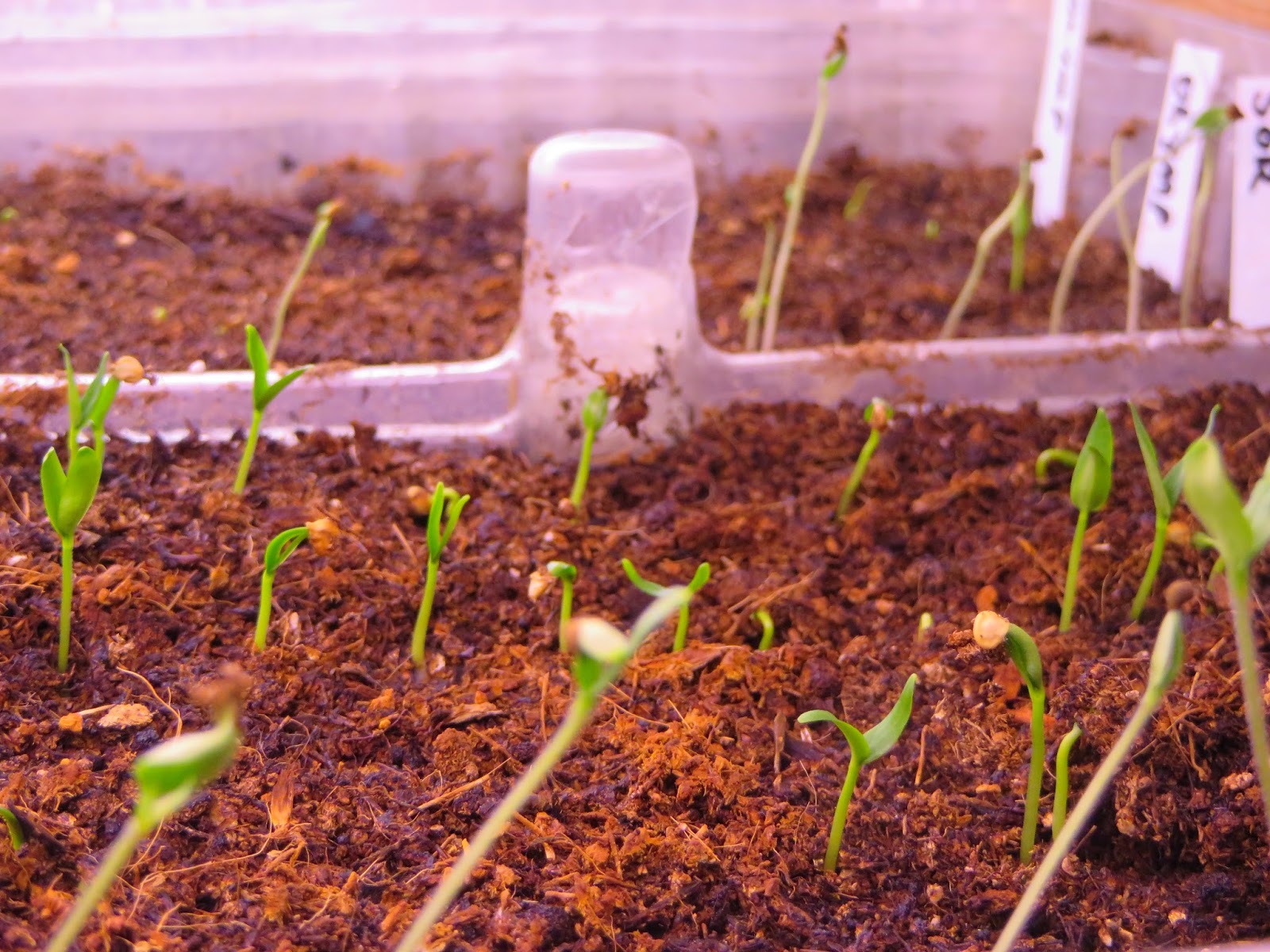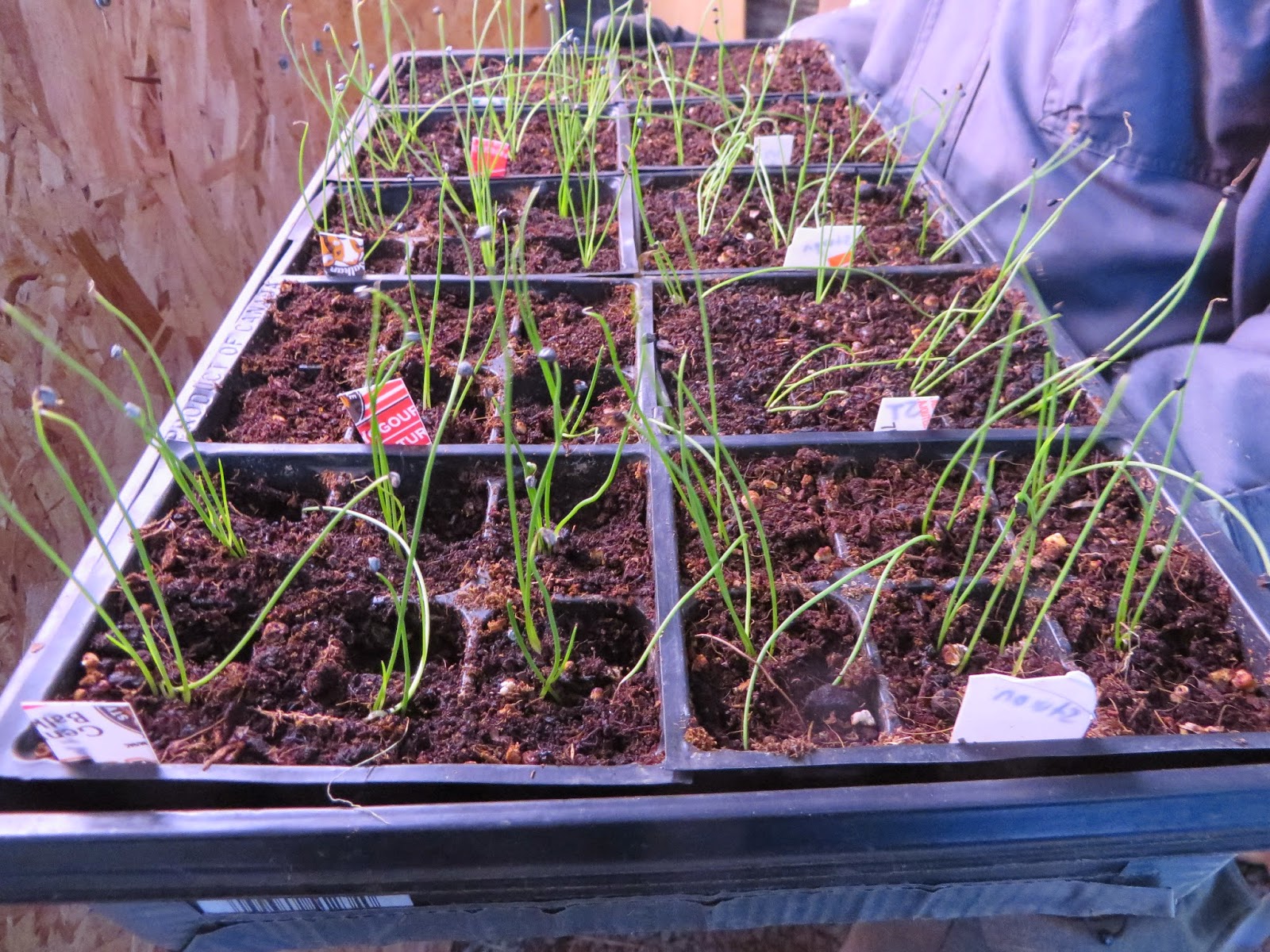 Not much change here. The plants seem healthy, despite a 'damping off scare' earlier this week. I lost one new zealand spinach sprout.
Not much change here. The plants seem healthy, despite a 'damping off scare' earlier this week. I lost one new zealand spinach sprout. Still way more plants than we need, so no need to worry.
It seems that the air circulation is not quite as thorough as I would like, some of the shelves are in a dead spot.
So every day when I go in to water the trays, I shift them around to ensure that all of plants get an equal amount of time nearest the fan.
The celery and celeriac (pictured above as of Mar 28) are entering what I consider their most susceptible period for this condition, so if there is a continuing problem, a canary or two will let me know.
I always plant more than I need, to ensure that little events such as this don't decrease the projected yield. Even if all of the plants did make it out of the nursery, there would not be enough room to transplant all of them.
The onions are a lot less scruffy and easier to manage after their haircut. These are trimmed down to about 1 - 2 inches, about a fifth of what they were a week ago.

The tomatoes are sprouting. These are the lime green and the moskvich.
Is it unfair to reference (at this time of year) to the rich flavour of moskvich? How about the thick wedges of great whites in a burger? Or the green and yellow lime greens providing a tart sweetness to salads? Or a tomato sauce made from a base of nothing other that sorrento cooking tomatoes (no water, no canned paste, just slow cooked tomatoes with a bit of Whitsend garlic, hot pepper, and maybe some thyme?
Even at this stage, when the trays are disturbed during the watering routine, the plants give off the unmistakable scent of their forthcoming fruit.
It drives me nuts with anticipation...
 The peppers are also sprouting. These (and the tomatoes) will be promoted up to 3" pots in a week, and then the big squeeze for space in the nursery shall begin.
The peppers are also sprouting. These (and the tomatoes) will be promoted up to 3" pots in a week, and then the big squeeze for space in the nursery shall begin. Shortly after that, the peppers will get their 'cold treatment'. This is a horticultural technique that I started doing two years ago, and refined somewhat last year.
The pepper seedlings are exposed to a controlled amount of cold over a period of time, which in turn forces the plants to set fruits a little earlier and with a slightly higher yield.
I believe it is one of the two factors that have contributed to our increasing pepper yield. Last year we finally had our big breakthrough, both in quantity and size per fruit.

Here is what the field is looking like after a week of (some) melting.
Of concern to me ne is the amount of water (now ice) that has pooled just east of the straw covered garlic beds. Evidently, something has changed in the field since last year, as there has never been pooled water in that area.
It is probable that when the east field was plowed late in the fall (after the pigs left), a natural drain was cut off. That will be easy enough to fix once the ground is thawed enough to work.
 In the meantime, I'll have to watch how it melts away from the garlic, a crop that does not enjoy flooding.
In the meantime, I'll have to watch how it melts away from the garlic, a crop that does not enjoy flooding. Worst case scenario, I'll have to remove some snow myself.
Work such as this (plus worrying) is what I'm paid for...
 Snow cover update April First:
Snow cover update April First:Here's a couple of photos of the north end of the field. The clover/rye paths have begun to appear. The water table is still quite high, the paths are saturated and would be damaged by walking upon them. The snow cover is somewhat uneven across the field (hence the snow you see in this image). Snowfall accumulates on the side of the field closest to the hedgerow.

You will see a photo of the compost taken about two weeks ago further down.
With the blue sky in the background, it is hard to believe that freezing rain is on the way tomorrow.
I took advantage of the fair weather yesterday and did some work on the hardening off shelter.
Ordinarily, this unit is where the seedlings are sent about a week or so before they are transplanted in the field, to help transition the to the tougher conditions outside.
I've added an additional layer of plastic sheeting on the inside, to further insulate the trays,
This will give me a little more space for the nursery when the lettuce, kale and chard get started in the coming weeks.
 Some of our plants are getting their start out here. I sowed some lemon balm and parsley in here. By the time these plants sprout, the temperature will have already started to moderate somewhat, these plants will have a head start on what life is like outside.
Some of our plants are getting their start out here. I sowed some lemon balm and parsley in here. By the time these plants sprout, the temperature will have already started to moderate somewhat, these plants will have a head start on what life is like outside.One other note, I started our Sage and Thyme. I will probably start some more catnip as well, we had one plant last year and it appeared to have been eaten/destroyed by being rolled in/torn up and taken away by a four -legged critter.
I don't have to blame the usual suspects, but it may have something to do with the lack of mice in the barn this season.

















